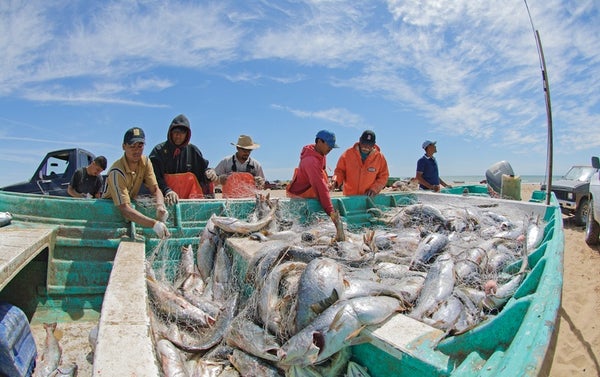When Gulf corvina mate, they are not shy about making noise. Every year the species' entire population gathers off the coast of Mexico to spawn. Like crickets, cicadas and frogs, male corvina produce a thumping love song that likely acts as a come-hither signal for females. The resulting underwater din turns out to be the highest-decibel fish noise ever recorded, even rivaling whale song—making it one of the loudest naturally produced sounds in the ocean, according to a study published last December in Biology Letters.
“At first, we thought our equipment was broken,” says co-author Brad E. Erisman, a fisheries ecologist at the University of Texas at Austin. “No one anticipated fish would be this loud.”
Erisman and his colleagues traveled to the Colorado River Delta, which empties into the Sea of Cortez. It is here and only here that Gulf corvina come to spawn, probably because the delta's extreme 25-foot-plus (eight-meter) tides help to flush their fertilized eggs out to sea. The researchers measured the sound produced by the fish using an echo sounder (a sonar unit) and a hydrophone (underwater microphone). Based on the vocalizations, they estimated there were as many as 1.5 million fish in a 17-mile (27-kilometer) stretch of river channel during one peak spawning day. The total population is likely much higher, the scientists say.
On supporting science journalism
If you're enjoying this article, consider supporting our award-winning journalism by subscribing. By purchasing a subscription you are helping to ensure the future of impactful stories about the discoveries and ideas shaping our world today.
.png?w=900)
Credit: Amanda Montañez; Source: “A Sound Worth Saving: Acoustic Characteristics of a Massive Fish Spawning Aggregation,” by Brad E. Erisman and Timothy J. Rowell, in Biology Letters, Vol. 13, No. 12; December 2017
More than 1,000 fish species produce sounds, but the researchers found the Gulf corvina to be in a class by itself. At 177 decibels, an individual corvina's mating call is louder than the equivalent of standing next to the stage at a rock concert. The noise is so intense that it may harm the hearing of other marine animals caught up in the action. “This paper is solid, and the findings are convincing,” says Stephen Simpson, a marine biologist and fish ecologist at the University of Exeter in England, who was not involved in the research.
The fact that the Gulf corvina gather in a single estuary to breed year after year makes them highly vulnerable to overfishing. “Lots of fishes are heavily exploited and endangered because of this amazing behavior where they come together to spawn,” Erisman says. In the age of gillnets and trawls, the evolutionary advantages of group spawning can paradoxically imperil the species' survival. —Rachel Nuwer
